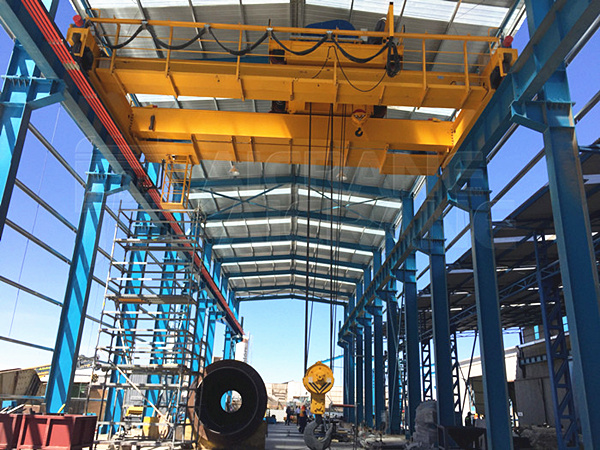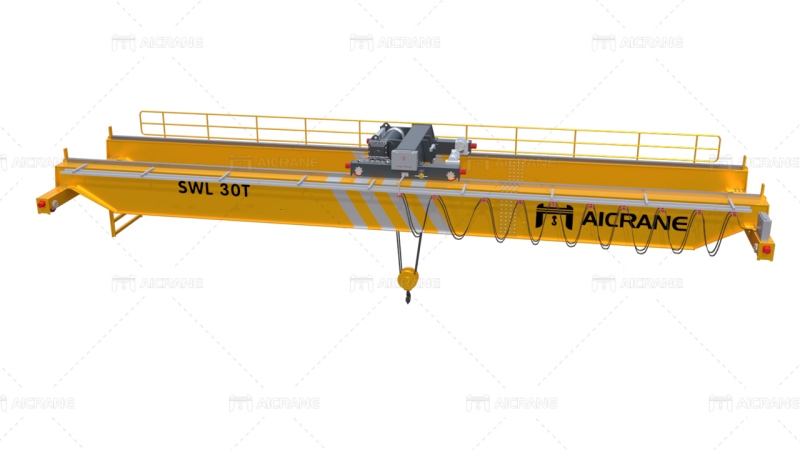Overhead Electric Overhead Travel (EOT) cranes are indispensable tools in industrial environments, revolutionizing material handling processes and enhancing workflow efficiency. These cranes, with their ability to lift and transport heavy loads across large areas, play a pivotal role in optimizing productivity, ensuring safety, and maximizing space utilization. This article explores how overhead EOT cranes improve workflow in industrial settings, focusing on their operational benefits, integration with modern technologies, maintenance best practices, and real-world applications.

Operational Benefits of Overhead EOT Cranes
Overhead EOT cranes are designed to facilitate the movement of heavy materials in manufacturing plants, warehouses, and construction sites. They typically consist of a bridge-like structure that runs along elevated runways supported by structural columns. The hoist mechanism, mounted on the bridge, travels horizontally to lift and transport loads with precision and efficiency. Here are the key operational benefits:
Efficient Material Handling
One of the primary advantages of overhead EOT cranes is their efficiency in material handling. Unlike manual methods or traditional forklifts, which may require multiple trips or operators to handle heavy items, EOT cranes can lift and transport loads swiftly and safely. This capability significantly reduces handling time and increases overall productivity in industrial operations.
Optimized Use of Vertical Space
EOT cranes operate overhead, utilizing vertical space effectively. By lifting loads vertically and horizontally across the workspace, these cranes maximize floor space utilization. This is particularly beneficial in crowded or compact environments where every square meter counts for storage or operational processes. The eot crane can be single girder or double girder bridge crane as required to meet different lifting needs.
Enhanced Safety Features
Safety is paramount in industrial settings, especially when handling heavy or delicate materials. Overhead EOT cranes are equipped with advanced safety features such as overload protection, emergency stop buttons, and anti-collision systems. These features ensure safe operation and minimize the risk of accidents, protecting both workers and equipment.
Versatility and Adaptability
Overhead EOT cranes are versatile tools that can be customized to suit specific operational requirements. They can handle a wide range of loads, from small components to large machinery, and can be equipped with various hoist configurations to accommodate diverse lifting needs. This adaptability makes them suitable for different industries and applications.

Integration with Modern Technologies
Advancements in technology have further enhanced the capabilities and functionalities of overhead EOT cranes, making them integral components of modern industrial workflows:
Automation and Remote Operation
Many modern EOT cranes are equipped with automation features that enable remote operation. Operators can control the crane’s movements and lift loads from a safe distance using remote control systems. This automation improves efficiency, reduces operator fatigue, and enhances precision in material handling tasks.
Internet of Things (IoT) Connectivity
IoT-enabled EOT cranes can be connected to a network, allowing for real-time monitoring of crane performance and operational data. IoT sensors collect information on factors such as load weight, crane movements, and maintenance needs. This data can be analyzed to optimize overhead crane usage, schedule predictive maintenance, and improve overall operational efficiency.
Data Analytics and Predictive Maintenance
Data analytics software can analyze the operational data collected from EOT cranes to identify patterns, trends, and potential issues. Predictive maintenance algorithms can predict equipment failures before they occur, allowing maintenance teams to schedule repairs proactively and minimize downtime. This proactive approach improves crane reliability and reduces maintenance costs over time.
Maintenance Best Practices
Regular maintenance is essential to ensure the continued efficiency and longevity of overhead EOT cranes:
- Routine Inspections: Conduct regular inspections of the crane’s structural components, electrical systems, and mechanical parts to detect signs of wear, corrosion, or damage.
- Lubrication: Keep moving parts well-lubricated to reduce friction and wear. Use manufacturer-recommended lubricants and follow a scheduled lubrication program.
- Operator Training: Provide comprehensive training for crane operators to ensure they understand safe operating procedures, load capacities, and emergency protocols.
- Manufacturer Support: Work closely with the crane manufacturer or a certified service provider to perform scheduled maintenance and address any technical issues promptly.
Real-World Applications
Overhead EOT cranes find extensive applications across various industries, demonstrating their versatility and impact on workflow improvement:
- Manufacturing: Used for lifting and positioning raw materials, components, and finished products on assembly lines and production floors.
- Warehousing: Facilitate efficient storage and retrieval of goods, optimizing inventory management and order fulfillment processes.
- Construction: Assist in the installation of heavy construction materials and equipment at building sites, enhancing construction workflow efficiency.
Overhead EOT cranes are essential assets for improving workflow efficiency in industrial environments. With their efficient material handling capabilities, advanced safety features, integration with modern technologies, and adherence to maintenance best practices, these cranes contribute significantly to productivity, safety, and operational excellence. As industries continue to evolve, the role of overhead EOT cranes in optimizing workflow and driving efficiency is expected to expand, driving further innovations and advancements in material handling practices.